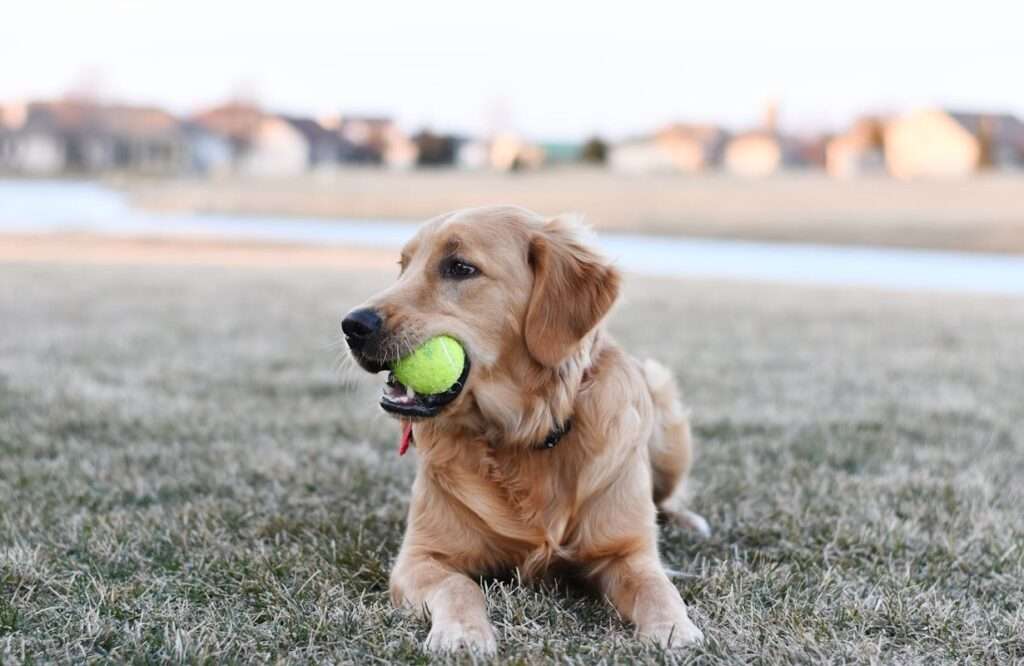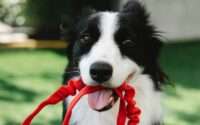Why Do Dogs Love Tennis Balls? Revealing the Truth Behind the Obsession
When it comes to our furry companions, there’s often a curious fascination with tennis balls that seems to transcend breed, size, or age. Dogs of all kinds seem to have an innate attraction to these brightly colored orbs, chasing after them with boundless enthusiasm.
But what exactly is it about tennis balls that captures the hearts of our canine friends? In this exploration, we delve into the intriguing world of why do dogs love tennis balls, uncovering the hidden secrets behind this timeless canine obsession.
The Evolutionary Perspective
From their earliest days as wild canines, dogs have been hardwired with certain instincts and behaviors that have helped them survive and thrive in their environments. One such instinct is the innate drive to chase and capture prey—a behavior that’s deeply ingrained in their genetic makeup. This primal urge to hunt and capture moving objects is a fundamental aspect of a dog’s evolutionary history.
In the wild, dogs would have relied on their keen senses and quick reflexes to pursue and catch prey, such as small mammals or birds. The sight of a tennis ball bouncing and rolling across the ground triggers this ancient instinct in our domesticated canine companions, igniting a surge of excitement and energy. It’s as if a dormant hunting instinct awakens within them, compelling them to chase after the tantalizing target with single-minded determination.
This evolutionary perspective sheds light on why dogs are so irresistibly drawn to tennis balls—it taps into a primal drive that’s been hardwired into their DNA for countless generations. As we continue our exploration, we’ll uncover more layers of this fascinating phenomenon, delving into the sensory appeal, social dynamics, and psychological underpinnings behind dogs’ love for tennis balls.
The Sensory Appeal

What is it about tennis balls that makes them so irresistible to our canine companions? One aspect is undoubtedly their sensory appeal. With their vibrant colors and high visibility, tennis balls stand out against any backdrop, capturing a dog’s attention with ease. Their bright hues—often fluorescent green or yellow—seem to beckon dogs from afar, enticing them to give chase and pounce with unbridled enthusiasm.
But it’s not just the visual appeal that makes tennis balls so enticing. These spherical toys possess a unique combination of characteristics that stimulate multiple senses in dogs. The bouncy and unpredictable movements of a tennis ball add an element of excitement to playtime, keeping dogs engaged and entertained for hours on end. Whether it’s a high bounce off the ground or a playful roll across the floor, each movement triggers a flurry of activity and anticipation in our furry friends.
Additionally, the texture and mouthfeel of tennis balls add to their sensory appeal. Dogs enjoy the tactile sensation of sinking their teeth into the soft, felt-like surface of a tennis ball, grasping it firmly in their jaws as they carry it triumphantly around the yard or living room. This tactile experience adds an extra dimension to playtime, enhancing the overall enjoyment for dogs and strengthening their bond with their human companions.
The Social and Bonding Aspect
Beyond the sensory allure, there’s also a social and bonding aspect to dogs’ love for tennis balls. Play is an essential component of canine socialization, providing dogs with opportunities to interact and communicate with both humans and other dogs. When we engage in a game of fetch or chase with our furry friends, we’re not just providing them with physical exercise—we’re also strengthening our bond and deepening our connection with them.
Tennis balls serve as valuable tools for interactive play between dogs and their human companions. Whether it’s a game of fetch in the backyard or a spirited round of indoor catch, the simple act of tossing a tennis ball back and forth fosters a sense of camaraderie and cooperation between dogs and their owners. It’s a shared experience that transcends language barriers, allowing us to communicate and connect with our canine friends on a deeper level.
Furthermore, the excitement and joy that dogs experience during playtime with tennis balls can have positive ripple effects on their overall well-being. As they romp and frolic in pursuit of their favorite toy, dogs release pent-up energy and stress, promoting mental and emotional balance. This shared enjoyment of play strengthens the human-dog bond, creating cherished memories that last a lifetime.
The Psychological and Physical Benefits

The love affair between dogs and tennis balls goes beyond mere amusement—it also offers a myriad of psychological and physical benefits for our canine companions. Engaging in play with tennis balls provides dogs with much-needed mental stimulation, keeping their minds sharp and active. The excitement of chasing after a bouncing ball taps into their natural instincts and provides an outlet for their boundless energy, preventing boredom and alleviating stress.
In addition to mental stimulation, playing with tennis balls also offers significant physical benefits for dogs. Running, jumping, and retrieving a tennis ball engages multiple muscle groups, promoting cardiovascular health and muscle tone. Regular exercise with tennis balls helps dogs maintain a healthy weight, reducing the risk of obesity and related health issues. Furthermore, the repetitive motions involved in fetching and retrieving can improve coordination and agility, enhancing overall physical fitness.
By incorporating tennis balls into our dogs’ playtime routines, we’re not just providing them with entertainment—we’re also investing in their long-term health and well-being. The joy and satisfaction they derive from chasing after their favorite toy are palpable, enriching their lives in ways both tangible and profound.
The Pavlovian Conditioning
The association between dogs and tennis balls often extends beyond mere play—it can also involve a fascinating phenomenon known as Pavlovian conditioning. Named after the renowned Russian physiologist Ivan Pavlov, this type of conditioning occurs when a neutral stimulus (such as a bell) becomes associated with a meaningful event (such as mealtime) through repeated pairings.
In the case of tennis balls, dogs may develop a Pavlovian response to the sight or sound of their favorite toy. Over time, the repeated experience of chasing after and retrieving a tennis ball becomes intertwined with feelings of excitement and anticipation. As a result, the mere sight or mention of a tennis ball can trigger a surge of enthusiasm and energy in dogs, signaling the onset of playtime and adventure.
This Pavlovian conditioning not only adds an extra layer of enjoyment to dogs’ interactions with tennis balls but also serves as a powerful tool for training and behavior modification. By pairing the presentation of a tennis ball with positive reinforcement, such as treats or praise, we can shape desired behaviors in our canine companions and strengthen the bond between us. In this way, tennis balls become more than just toys—they become symbols of connection and camaraderie between dogs and their human companions.
The Role of Breed Characteristics
While the love for tennis balls is widespread among dogs, the degree of enthusiasm can vary depending on breed characteristics. Certain breeds are known for their strong prey drive and retrieving instincts, making them particularly drawn to the thrill of chasing after and retrieving tennis balls. Breeds such as Retrievers, Border Collies, and Australian Shepherds are often avid fans of fetch games, eagerly pursuing tennis balls with unmatched zeal and determination.
On the other hand, breeds with lower energy levels or less pronounced prey drive may exhibit less interest in tennis balls or prefer alternative forms of play. Breeds such as Bulldogs, Pugs, and Basset Hounds may enjoy a leisurely game of tug-of-war or a relaxing stroll over a high-energy game of fetch. Understanding your dog’s breed characteristics and preferences can help tailor playtime activities to suit their individual needs and interests.
Potential Risks and Considerations

While playing with tennis balls can offer numerous benefits for dogs, it’s essential to be aware of potential risks and considerations to ensure the safety and well-being of our canine companions.
- Choking Hazards: Tennis balls can pose a choking hazard, especially for dogs who like to chew or aggressively retrieve them. Monitor your dog’s playtime closely and replace damaged or worn-out tennis balls to prevent choking incidents.
- Ingestion Risks: Dogs may accidentally ingest pieces of tennis balls while playing, leading to digestive issues or blockages. Choose appropriately sized tennis balls for your dog and supervise play to minimize the risk of ingestion.
- Overexertion: Intense or prolonged play sessions with tennis balls can lead to overexertion and fatigue, particularly in dogs prone to joint issues or obesity. Monitor your dog’s activity level and take regular breaks to prevent strain or injury.
- Dental Health: Chewing on tennis balls can cause wear and tear on your dog’s teeth, leading to dental issues such as fractures or enamel erosion. Provide dental-safe toys and incorporate dental hygiene practices into your dog’s routine to maintain oral health.
By being mindful of these potential risks and considerations, you can ensure that playing with tennis balls remains a safe and enjoyable experience for your furry friend. With proper supervision and precautions, you can continue to nurture the bond between you and your dog while indulging in the timeless joy of fetch and play.
Tips for Safe and Enjoyable Play
Ensuring safe and enjoyable play with tennis balls is essential for maintaining your dog’s well-being and happiness. Here are some tips to help you make the most of your playtime sessions:
- Choose Appropriately Sized Tennis Balls: Select tennis balls that are the right size for your dog’s mouth to minimize the risk of choking or ingestion.
- Supervise Play Sessions: Keep a close eye on your dog during playtime with tennis balls, intervening if they show signs of fatigue or if the ball becomes damaged.
- Rotate Toys Regularly: Rotate your dog’s toys regularly to keep playtime exciting and prevent overuse of tennis balls, which can lead to boredom or fixation.
- Incorporate Training and Interactive Games: Use tennis balls as tools for training and interactive games to engage your dog’s mind and promote bonding.
- Consider Alternatives: Explore alternative toys and activities to provide variety and stimulation for your dog, such as puzzle toys or flirt poles.
- Practice Dental Hygiene: Incorporate dental hygiene practices into your dog’s routine to maintain oral health, such as brushing their teeth regularly and providing dental-safe toys.
By following these tips, you can create a safe and enjoyable play environment for your dog while nurturing the special bond you share.
Conclusion
The enduring love affair between dogs and tennis balls is a testament to the unique connection we share with our canine companions. From their innate instincts and sensory appeal to the social dynamics and psychological benefits they offer, tennis balls play a significant role in enriching the lives of dogs and their human companions.
As we’ve explored in this article, the reasons behind dogs’ fascination with tennis balls are multifaceted and deeply ingrained in their nature. Understanding the role of breed characteristics, potential risks, and safety considerations is essential for ensuring that playtime remains a positive and enriching experience for our furry friends.
So the next time you reach for a tennis ball and see the spark of excitement in your dog’s eyes, remember the profound impact that this simple toy can have on their well-being and happiness. Embrace the joy of play, cherish the moments shared, and celebrate the timeless bond between dogs and their beloved tennis balls.
Frequently Asked Questions
Why do dogs love tennis balls so much?
Dogs are naturally drawn to tennis balls due to their bright colors, bouncy movements, and texture, which triggers their instinctual prey drive.
Is it safe for my dog to play with tennis balls?
While tennis balls are generally safe, it’s essential to monitor your dog during play to prevent choking hazards or ingestion of small pieces.
How can I train my dog to fetch a tennis ball?
Start by teaching basic commands like “fetch” and “drop it,” and use positive reinforcement techniques such as treats or praise to encourage desired behavior.
Can playing with tennis balls help with my dog’s exercise needs?
Yes, playing fetch with tennis balls provides dogs with both physical exercise and mental stimulation, helping to keep them healthy and happy.
Are there any alternatives to tennis balls for dog playtime?
Yes, there are many alternatives such as rubber balls, frisbees, or plush toys that can provide similar interactive play experiences for your dog.
Should I be concerned about my dog chewing on tennis balls?
Excessive chewing on tennis balls can cause dental issues or wear down their teeth. Monitor your dog’s chewing habits and consider dental-safe toys as alternatives.
How do I know if my dog is getting tired during playtime with tennis balls?
Watch for signs of fatigue such as heavy panting, slowing down, or disinterest in retrieving the ball. Take regular breaks and provide water to keep your dog hydrated.
Can playing with tennis balls help strengthen the bond between me and my dog?
Yes, interactive play with tennis balls fosters bonding and communication between dogs and their owners, strengthening the human-dog relationship.
Are there specific breeds that are more likely to enjoy playing with tennis balls?
Breeds with high energy levels and retrieving instincts, such as Retrievers and Border Collies, are often particularly fond of playing fetch with tennis balls.
How can I ensure that playtime with tennis balls remains safe for my dog?
Supervise play sessions, choose appropriately sized balls, and inspect them regularly for damage. Replace worn-out or damaged balls to prevent choking hazards or injuries.




